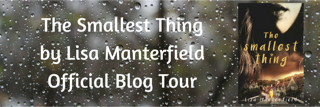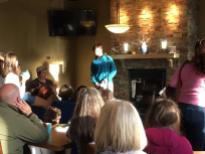 With the support of Westside Pizza and the Kitsap Regional Library, we threw another Teen Story Slam and packed the house again. Local high school teacher (and playwright) Noah Barfield was a fabulous emcee. Parents, teachers, and adults lined the back of the restaurant, while every table was packed with teen writers and their friends. The peer support was phenomenal. The stories, poems, chapters and essays read were among the finest we’ve had. Around the room, tears were shed for poignant pieces about gender roles, the loss of love, and facing grief head-on. Conversely, there were comedians among our writers, earning cheers, hoots of laughter, and huge rounds of applause. It was incredible. Each time we present Teen Story Slam, our community of student writers elevates the event beyond our dreams, displaying talent, maturity, insight, and bravery.
With the support of Westside Pizza and the Kitsap Regional Library, we threw another Teen Story Slam and packed the house again. Local high school teacher (and playwright) Noah Barfield was a fabulous emcee. Parents, teachers, and adults lined the back of the restaurant, while every table was packed with teen writers and their friends. The peer support was phenomenal. The stories, poems, chapters and essays read were among the finest we’ve had. Around the room, tears were shed for poignant pieces about gender roles, the loss of love, and facing grief head-on. Conversely, there were comedians among our writers, earning cheers, hoots of laughter, and huge rounds of applause. It was incredible. Each time we present Teen Story Slam, our community of student writers elevates the event beyond our dreams, displaying talent, maturity, insight, and bravery.Our 3rd Teen Story Slam was AMAZING
 With the support of Westside Pizza and the Kitsap Regional Library, we threw another Teen Story Slam and packed the house again. Local high school teacher (and playwright) Noah Barfield was a fabulous emcee. Parents, teachers, and adults lined the back of the restaurant, while every table was packed with teen writers and their friends. The peer support was phenomenal. The stories, poems, chapters and essays read were among the finest we’ve had. Around the room, tears were shed for poignant pieces about gender roles, the loss of love, and facing grief head-on. Conversely, there were comedians among our writers, earning cheers, hoots of laughter, and huge rounds of applause. It was incredible. Each time we present Teen Story Slam, our community of student writers elevates the event beyond our dreams, displaying talent, maturity, insight, and bravery.
With the support of Westside Pizza and the Kitsap Regional Library, we threw another Teen Story Slam and packed the house again. Local high school teacher (and playwright) Noah Barfield was a fabulous emcee. Parents, teachers, and adults lined the back of the restaurant, while every table was packed with teen writers and their friends. The peer support was phenomenal. The stories, poems, chapters and essays read were among the finest we’ve had. Around the room, tears were shed for poignant pieces about gender roles, the loss of love, and facing grief head-on. Conversely, there were comedians among our writers, earning cheers, hoots of laughter, and huge rounds of applause. It was incredible. Each time we present Teen Story Slam, our community of student writers elevates the event beyond our dreams, displaying talent, maturity, insight, and bravery.Filed under For the love of writing, Your highest potential
Reading Opens Minds selects Radio Head as a book club pick!
I’m thrilled to announce that Reading Opens Minds has chosen my novel RADIO HEAD for book club participants, thanks in part to a generous donation from the John Aaroe Group.
Designed to reach those most in need, Reading Opens Minds book clubs encourage the shared experience of reading and discussion to nurture self-worth, foster empathy, encourage meaningful communication and increase sense of community. By providing new books and mentors we envision comprehensive literacy as a gateway to success and an opportunity to expand understanding, benefiting individuals and the greater good. Learn more at www.readingopensminds.org.
Filed under For the love of writing, Your highest potential
Teen Story Slam is back! Write a story, read it aloud, get a prize
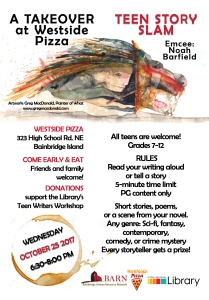 The teen writers asked for it, so we’re bringing it back! On October 25, 2017, the Teen Story Slam returns to Westside Pizza!
The teen writers asked for it, so we’re bringing it back! On October 25, 2017, the Teen Story Slam returns to Westside Pizza!
Teen creative writers in grades 7-12 are invited to step up to the mic to read their own prose for 5 minutes. Anything goes: a short story, a scene from their novel or screenplay, poetry, or wild and wacky true stories. Just keep it PG, please. Every writer who participates gets a prize! No competition, no memorization, just pure storytelling awesomeness.
In partnership with Bainbridge Artisan Resource Network (BARN), the Kitsap Regional Library, and Westside Pizza, benefits from the event will support our Teen Writers Workshop afterschool writing program, and Teen Creative Writing Summer Camp.
Beloved Bainbridge High School English teacher Noah Barfield will serve as master of ceremonies once again. Mr. Barfield is known in the community for his achievements as a playwright, and among his students as a comedian.
At the inaugural Teen Story Slam we had 23 intrepid writers who kept the standing-room-only audience rapt. Teens, sign up now! Registration is encouraged. Family and friends are welcome to come cheer on the writers!
WHEN: Wednesday, October 25, from 6:30 – 8:30 pm
WHERE: Westside Pizza, 323 High School Rd NE, Bainbridge Island, WA 98110
SIGN UP at the Reference Desk at the Bainbridge Library, or by calling 206-842-4162
*Can’t wait? Drop in to Teen Writers Workshop–it’s free! Facilitated by me and author Margaret Nevinski, MFA, students in grades 7-12 meet at the library on the 2nd Thursday of every month during the school year, from 3:30-5:00 pm.
My latest on HuffPo: How Sharing Stories Helps Kids (To Help Other Kids)
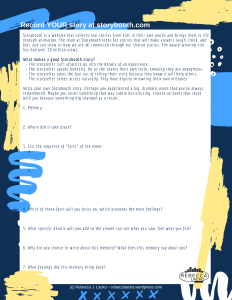
Want to write your own storybooth.com story? Here is the memoir lesson handout used at the creative writers’ camp for teens.
Please read my latest article on Huffington Post:
storybooth: How Sharing Stories Helps Kids (To Help Other Kids)
Seventh-grade student Carissa carried a painful memory around with her, but it wasn’t a secret. There were plenty of kids who witnessed (her now ex) boyfriend humiliate and verbally abuse her in the hallway at school. While the scene replayed in her head every day for the next year, she wouldn’t talk about it openly with anyone.
Carissa does have a secret, however. She’s a talented writer, and she explores her thoughts and personal challenges through short stories. This summer, she attended a free creative writers’ camp for teens at her local library. Every day, the students were provided writing prompts and mini lessons to create stories, poems, and scenes for novels-in-progress. This year, the students were introduced to storybooth (storybooth.com), a website that collects real stories from kids in their own words and brings them to life through animation. Kids of all ages are welcome to record their own personal experiences that made a lasting impact on their lives, whether positive, negative, or downright hilarious. It’s free, easy, and has the power to relieve a weighty burden – something that no other platforms for young people are doing. The act of recording a story is an effective means of letting it go, and not only that, the kids have a supportive community behind them.
The team at storybooth looks for stories that will make viewers laugh, think, and feel, and has a way of showing us how we are all connected through our shared stories. The award-winning site has over 100 million views, with multi-ethnic, compassionate and often humorous animations. But the most significant part of storybooth is the community response. As a digital platform unlike other social media sites, storybooth is an overwhelmingly supportive and safe place for kids to share their personal journeys. The peer comments are encouraging, understanding and uplifting.
When participants in the teen writing camp viewed several stories and took part in a short lesson on memoir writing, several felt empowered to put their own experiences into words. One student wrote about her family moving several times throughout her life and how difficult it is to say goodbye. Another talked about crashing a car through the family’s garage on his first day of driving school. (He’s still afraid to test for his license.) Carissa dared to read her story about the very public embarrassment that haunted her for months, discovering a sense of peace by dissolving the memory of its power. When kids reveal their authentic feelings, it can help other kids gain a fresh perspective on their own struggles.
What makes a good storybooth story?
- The storyteller allows him or herself to be vulnerable. They’re not afraid to go into the details of an experience.
- The storyteller looks at him or herself honestly. They expose their own truth, knowing they are anonymous and no one is judging.
- The storyteller takes the fear out of telling their story because they know it will help others.
- The storyteller comes across naturally. They are authentic, have dignity in owning their own mistakes, and just let themselves go.
For teens who are interested in visiting storybooth.com and sharing the story that’s been replaying through their head, simply visit storybooth.com, hit “record” – and then let it go. Those looking for some extra guidance can consider writing out the story ahead of time – the memoir writing exercise developed by the creative writers’ camp for teens is available here. If the story is chosen by the storybooth team, it’ll be animated and posted to the website. Other kids will have a chance to see the story and comment, and perhaps be inspired to write and record their own story.
Filed under Freelance Writing, Your highest potential
Book Release Day! Lisa Manterfield’s new novel The Smallest Thing
One of the most exciting parts of living a creative life is finding kindred souls along the journey. I had the good fortune of meeting author Lisa Manterfield several years ago at the UCLA Writer’s Studio, and I quickly discovered I’d found a both a talented writer and cherished friend. Lisa’s writing is a marriage of science and emotion. An accomplished writer of both fiction and nonfiction, Lisa is unafraid to venture along the dark and curving paths of human experience (or climb onto high, precarious ledges). She invites her readers to the call of the wild while awakening a sense of timelessness and gravity, united with both the earth and beyond. Wherever Lisa takes her reader, you can be certain it’s new territory and you wouldn’t want to be there without her as a guide.
Lisa Manterfield is the award-winning author of A Strange Companion and I’m Taking My Eggs and Going Home: How One Woman Dared to Say No to Motherhood. Her work has appeared in The Saturday Evening Post, Los Angeles Times, and Psychology Today. Originally from northern England, she now lives in Southern California with her husband and over-indulged cat.
Her newest book releases today! I’m honored to be among the first to announce Lisa Manterfield’s latest novel, The Smallest Thing. In celebration, you can ENTER TO WIN a lovely swag box that includes a signed copy of The Smallest Thing and some fabulous gifts. We chatted about her experience researching and writing the story, and why her protagonists’ fathers tend to figure so prominently. I got the inside scoop on how published authors can find effective book marketing techniques that work for their readerships.
Ok, let’s begin! First, tell us what The Smallest Thing is about.

LM: When 17-year-old Emmott finds herself trapped in her tiny English village by a government-imposed quarantine, she must choose between saving herself at all costs or doing what’s right for the people she loves the most.
RL: What is the category and genre? Did you plan to write for this audience, or did the story dictate its own voice?
LM: The book is contemporary YA with a strong cross-over into Adult. I didn’t set out to write YA. I tend to write for a slightly older reader, but I needed to tell this story and my main character dictated the category. She was pretty adamant about telling it her way.
RL: This has been a very big year for you as an author! You’ve released not one, but two books, A Strange Companion and The Smallest Thing. How are they similar, and how are they different?
LM: They are both stories that demanded to be told and stuck with me until I wrote them. They’re both set in Northern England, in surroundings that are very familiar to me, and they both have young female protagonists who don’t always behave well. Both Kat and Em make some poor choices in their stories and don’t always treat people as well as they know they should, but in the process, they both learn a lot about who they really are. In both stories, there is a romance element, a struggle with family dynamics, and of course, death. Love, loss, and family always seem to crop up in my work.
Beyond that, my first novel, A Strange Companion, is a coming-of-age love story with paranormal elements. The Smallest Thing is a big mash-up of adventure, thriller, sci-fi, and romance. At their cores, though, they are still stories of young women figuring out who they are in the world.
RL: The Smallest Thing is loosely based on a true story about Eyam, “The Plague Village,” in Derbyshire, England. Can you tell us a little about the historical facts that inspired your novel?
LM: I grew up not far from Eyam and have always been fascinated by the story of self-sacrifice. The Great Plague was raging in London in 1665 and found its way to Eyam, some 150 miles away, when a local tailor brought in a bolt of cloth containing fleas (probably not unusual at that time.) When people in Eyam began succumbing to the plague, the villagers, led by the local vicar, made the decision to quarantine their village to prevent the spread of the disease to surrounding villages and to the thriving market town of Sheffield, my hometown. That decision saved untold thousands of lives, but cost the village dearly. All told, 260 of the 350 villagers lost their lives.
One of the personal stories that stayed with me is that of Emmott Syddall, a young woman whose fiancé lived outside the quarantine zone. It’s rumored they continued their courtship at a safe distance across the village boundary. Rowland Torre was reportedly one of the first to enter the village when the quarantine was lifted. Only then did he learn that Emmott had not survived. I took a great many liberties with the facts in my contemporary version, but the themes of love, self-sacrifice, and community are still what drives the story.
RL: You and I share the trait of writing young characters with dead or absent fathers. What is the significance of this in your stories?
LM: Ah yes. My dad died suddenly when I was 15. Thirty years later, I am still trying to work my way through that in my fiction. While neither of my novels is a fictionalized version of my personal story, there are elements of me in there. Like Kat, I was not prepared for the loss of my dad and, also like Kat, it took me a long time to work through my grief and move on. I suppose with Em, I was exploring what it might have been like to try to break away from my dad’s expectations for me, and be my own person. I imagine it would have been just as contentious as Em’s battle for independence, but hopefully not in such a terrible environment.
RL: Your protagonist Emmott is separated from her boyfriend when her village is quarantined. Under the same circumstances, how do you think you’d fare if your wonderful husband Mr. Fab and your devoted kitty Felicity were across Cucklett Delf?
LM: Astute readers will notice that there are no pets in the village. I made a deliberate choice to exclude them. I had no trouble writing terrible deaths for people, but I couldn’t bring myself to do it to the pets.
But, as you’re forcing me to imagine this scenario, I think I would be very grateful that Felicity and Mr. Fab were out of harm’s way. And then I would get down to the business of self-preservation. I’d like to think that I would also be a good citizen and try to be helpful to those trapped with me. We never really know how we’ll respond in crisis until it happens. Generally, I’m pretty cool under pressure, but who knows how I’d act if my life were truly in danger.
RL: Your biweekly inspiring blog posts have attracted a wonderful community of newsletter subscribers. Do you have any book marketing advice for indie authors?
LM: There are mountains of really solid information out there from authors who are insanely successful and have more information than I could offer. The problem is, there is SO much information and much of it is conflicting. It can be completely overwhelming for a new author. So my advice would be to read voraciously, gather information from several sources, and then walk away and think about what kind of author you are and what exactly you want from your career. Then pick the tools that will support that, take a deep breath, and do something that feels right. It may take some trial and error to find your groove, but it will end up being a lot more effective than hurling yourself into someone else’s best practice only to find it’s a poor fit.
RL: Do you maintain complete control over your characters or do they ever take the proverbial wheel?
LM: I tend to let them run wild and free in the first draft. I have an idea of what I’d like to happen, but I try to stay open to possibilities. The “mysterious man in the HAZMAT suit” in this novel was not in my original idea. He came out of a writing prompt, but the second he appeared, I knew he had to stay. His creation dramatically changed the course of the novel for the better.
RL: Do you miss the company of your characters when you finish writing a book?
LM: It took me ten years to write my first novel, A Strange Companion, largely because I couldn’t let go and call the book finished. Perhaps one of the hardest skills to master is finding that sweet spot between revising a book until it’s as good as it can be and knowing you’ve reached a point that there’s nothing more you can do and that more twiddling will only make the book worse. At that point, it’s time to move on.
When I’m working on a book, I am in that world with those characters. I wake up thinking about them and I talk to other people, not about the book as a whole, but about the characters by name. Once a book is finally finished, though, I go through a brief period of mourning, and then I let it go. And I’m a fickle lover; I’m already deep in a relationship with a whole new set of characters.
RL: Thank you, Lisa! I look forward to meeting your new characters and continuing our travels together on the journey of writing. Best of luck, wherever your creativity takes you.
The Smallest Thing is available now! (non-affiliate links)
Enter to WIN
a lovely swag box that includes a signed copy of The Smallest Thing and some fabulous gifts!
Click HERE to enter.
More about the book…
The Smallest Thing
By Lisa Manterfield
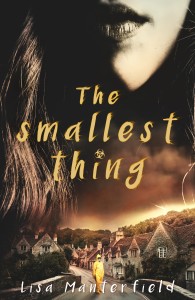 The very last thing 17-year-old Emmott Syddall wants is to turn out like her dad. She’s descended from ten generations who never left their dull English village, and there’s no way she’s going to waste a perfectly good life that way. She’s moving to London and she swears she is never coming back.
The very last thing 17-year-old Emmott Syddall wants is to turn out like her dad. She’s descended from ten generations who never left their dull English village, and there’s no way she’s going to waste a perfectly good life that way. She’s moving to London and she swears she is never coming back.
But when the unexplained deaths of her neighbors force the government to quarantine the village, Em learns what it truly means to be trapped. Now, she must choose. Will she pursue her desire for freedom, at all costs, or do what’s best for the people she loves: her dad, her best friend Deb, and, to her surprise, the mysterious man in the HAZMAT suit?
Inspired by the historical story of the plague village of Eyam, this contemporary tale of friendship, community, and impossible love weaves the horrors of recent news headlines with the intimate details of how it feels to become an adult—and fall in love—in the midst of tragedy.
ISBN: 978-0-9986969-2-8
Category: Upper Young Adult Fiction
Publication: July 18, 2017
Pages: 286
Size: 5.25 x 8.00 in.
Price: $15.95
Binding: Perfect Bound
Publisher: Steel Rose Press
Stay in touch with Lisa Manterfield!
http://www.LisaManterfield.com
Facebook: AuthorLisaManterfield
Instagram: @lmanterfield
Twitter: @lisamanterfield
Goodreads: LisaManterfield
Filed under Who is Writing What?
Sign up for Teen Writing Camp on Bainbridge Island!
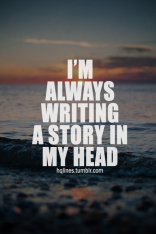 Calling all Kitsap area teens in grades 7-12! Join me and author Margaret Nevinski for a jam-packed week building your work-in-progress, creating new characters and stories, and strengthening your writing muscles. Every day, we’ll provide writing prompts and activities to stretch your creativity and range. We even have a special camp theme: Character motivation. (Why do our characters act, talk and behave the way they do? Let’s explore!) We’ll sharpen dialogue, delve into interactive memoir using Storybooth, and venture into ekphrastic writing with an art expert at Bainbridge Island Museum of Art (BIMA). (Bonus points if you know what “ekphrastic” means!)Starting the week in a dramatic setting, we’ll take over the auditorium at BIMA on Monday, Tuesday and Wednesday. On Thursday and Friday, we’ll meet up at our traditional writing headquarters at KRL’s Bainbridge Island Community Room, where we will be among the very first to use the refreshed and renovated space! Prepare to be impressed and writing in comfort and style:)
Calling all Kitsap area teens in grades 7-12! Join me and author Margaret Nevinski for a jam-packed week building your work-in-progress, creating new characters and stories, and strengthening your writing muscles. Every day, we’ll provide writing prompts and activities to stretch your creativity and range. We even have a special camp theme: Character motivation. (Why do our characters act, talk and behave the way they do? Let’s explore!) We’ll sharpen dialogue, delve into interactive memoir using Storybooth, and venture into ekphrastic writing with an art expert at Bainbridge Island Museum of Art (BIMA). (Bonus points if you know what “ekphrastic” means!)Starting the week in a dramatic setting, we’ll take over the auditorium at BIMA on Monday, Tuesday and Wednesday. On Thursday and Friday, we’ll meet up at our traditional writing headquarters at KRL’s Bainbridge Island Community Room, where we will be among the very first to use the refreshed and renovated space! Prepare to be impressed and writing in comfort and style:)
Wait, there’s more! Margaret and I will provide one-on-one consultation each day, campers will share their prose in The Writers’ Circle, and we will produce our own Literary Magazine. If that isn’t enough, we’re also hosting a A Reading and Celebration of the Teen Writing Camp at BARN! The Friday evening celebration will feature our own intimate Spoken Word event for all camp participants. Invite your family and friends to hear your stories, chapters, poems, and/or essays. Dessert will be served.
Our teen librarian Stefanie Reddy will provide yummy snacks daily. Your work-in-progress will thank you, and that shiny new journal will love the smell of fresh ink. We can’t wait to write with you!
Registration:
Where: Bainbridge Island
2 p.m. to 4 p.m.
A Reading and Celebration of the Teen Writing Camp at BARN
Recommended For: Grades 7 – 12
Filed under Fiction Novel Writing, For the love of writing
An introspective chat about my work, with author Lisa Manterfield
Sometimes we receive unexpected treats. An author interview allows us to pause a moment and consider why we’re doing the work we are, and what we’re really trying to say in our novels. Every time I’ve sat in the spotlight as interviewee, I’ve come away with a surprise insight about my journey, or an “aha!” moment about an issue I’d been struggling with. Recently, I  had the indulgent pleasure of being interviewed by a trusted confidante I hold in high esteem: Lisa Manterfield, author of the paranormal romance A Strange Companion.
had the indulgent pleasure of being interviewed by a trusted confidante I hold in high esteem: Lisa Manterfield, author of the paranormal romance A Strange Companion.
Please check it out to learn
How (and where!) Lisa and I first met
Why music plays such a big role in my novels
A discussion about dead daddies and the protagonists who love them
What I love about working teen writers
What I’m writing RIGHT NOW.

Filed under Fiction Novel Writing, For the love of writing
High and Mighty Low: An interview with the band
 I was asked today why music plays such a big role in my fiction writing, and I remembered an interview I did for Mixtape Methodology with the band High and Mighty Low while researching and writing my debut novel RADIO HEAD. The band covered The Beatles’ iconic song Blackbird, and it got me thinking about how a single song can leave an indelible mark on our lives, just as a good book might. Please read on and share the song that’s your jam.
I was asked today why music plays such a big role in my fiction writing, and I remembered an interview I did for Mixtape Methodology with the band High and Mighty Low while researching and writing my debut novel RADIO HEAD. The band covered The Beatles’ iconic song Blackbird, and it got me thinking about how a single song can leave an indelible mark on our lives, just as a good book might. Please read on and share the song that’s your jam.
A Brief Examination of High and Mighty Low’s Blackbird
*as published in Mixtape Methodology
What’s your jam? Maybe you heard your latest fave last night at the club. Or is your best-loved song an old favorite? Many music fans create playlists or vinyl collections featuring songs marking a significant time, or a rite of passage. The beginning of a relationship. Or its end. A song played on repeat in the privacy of headphones or on your morning commute is, for that moment, yours alone. What you listen to forms a lens, calibrating your worldview. When one powerful song becomes “my jam,” it’s the manifestation of your own anthem.
Singer-songwriter Marissa Nadler says Fake Plastic Trees, a song from Radiohead’s The Bends album, marked a musically significant point in her life. “The Bends came out in 1995, and I was 14 and just starting to learn the guitar.” Nadler wanted to sing Fake Plastic Trees; “It was the first time I really successfully played barre chords,” she said. “The Bends, along with [Nirvana’s] In Utero, and even [Hole’s] Live Through This, these were albums that soundtracked the teenage years for me.”
It’s kind of freakish to think about the ingredients that go into an original song. Assuming the band gets along and every member contributes his or her best material, a song comprises the amalgam of the group’s talent. It conveys an image and philosophy using lyrics, and an arrangement of notes to form a melody that carries its own story. A song sets a tone, and illustrates an atmosphere, combining instruments that both harmonize and counter. Arguably, a song is only an idea, rhetoric perhaps, until it is performed. Musicians and singers come to the mic with a personal aesthetic, an inborn message and style, and the restless desire to share their creation with an audience of listeners. The final production includes the input of accompanying musicians, producers, and audio engineers. And possibly Yoko Ono types.
But what about when a band chooses to cover another performer’s song, recording and releasing it alongside the group’s own original offerings? What’s the significance, a shoutout back to the original song-writer? Or perhaps it’s a revelation, a keepsake or a snapshot holding a truth about the performer covering it.
Kurt Cobain of Nirvana once remarked, “When I heard the Pixies for the first time, I connected with that band so heavily I should have been in that band. Or at least in a Pixies cover band.”
Like all music fans, musicians are drawn to songs that mattered to them, for whatever reason. Maybe their favorite marks a milestone. Maybe it gashed a deep wound leaving a lifelong scar, rendering that chosen song a souvenir that must be shared. A covered a song allows listeners to know a given performer on a deeper level than even his or her own creations might reveal. Call it trickle-down mastery, the artists who came before established and reinforced the foundation of modern music. A student’s mastery of an instrument or a vocal style is influenced by the teachers who lead the way, who held the light on the path. For professional performers, those teachers were often their favorite songs.
Los Angeles-based rock band High and Mighty Low is gaining a strong following with their debut album, Bones. The group is comprised of John DiBiase (guitar, vocals), Matt Boehm (guitar), Jeff Mallow (guitar), Scott Schneider (drums), and Rick Zaccaro (bass). Bones covers a broad field of guitar-heavy alternative rock, from the howling guitars featured in Taken to the blazing and energetic, The Tragedies We Hold, to a melodic nod to popular music with, Half The Time.
High and Mighty Low chose to release its debut album with a bonus track, a cover of The Beatles’ Blackbird. A song you’ve likely loved too at some point, Blackbird is listed among the top ten most covered songs, from a wide spectrum of performers in several music categories, from folk-infused Sarah McLachlan to an extraordinary arrangement by Alicia Keys, with only her piano as accompaniment. Pearl Jam’s Eddie Vedder and Foo Fighters’ Dave Grohl have often favored Blackbird at live shows.
Blackbird first appeared on The Beatles (also referred to as the White Album). Written and originally performed as a solo effort by Paul McCartney, Blackbird is credited nonetheless a Lennon-McCartney collaboration.
Blackbird is frankly a weird outtake from High and Mighty Low’s overall sound esthetic. Frontman John DiBiase offered some insight about why the band selected that particular song. Blackbird was recorded on June 11, 1968 (released November 25, 1968), decades before any member of the band was born. How does Blackbird speak for High and Mighty Low, building a bridge beyond the lyrics, melodies, and arrangements they’ve crafted for themselves?
“I love how stripped down that song is,” says DiBiase. “And the guitar playing is obviously fantastic by McCartney.” Stripping down seems to be a hot topic for the DiBiase and the band. The word “bones” happens to appear in a few tracks he wrote “Considering how stripped down some of the album is, I just felt Bones was an appropriate title,” DiBiase added.
According to Rolling Stone magazine, McCartney recorded Blackbird on his own. George Harrison and Ringo Starr were across the pond in California, and John Lennon was recording the song Revolution 9 in another studio. When they were school boys, Paul McCartney and George Harrison attempted to learn a Johann Sebastian Bach piece called Bourrée in E Minor, a song, like Nadler’s Fake Plastic Trees, which marked a significant period in their lives, and on the journey to learning their craft. It became, essentially, their jam. McCartney carried that musical souvenir into adulthood. He said that Blackbird’s fingerpicked guitar lines, written at his Scotland farm, were based on Bach’s Bourrée in E minor.
“Hearing him tap his foot is something,” says DiBiase, referring to the distinctive background sound many believed was merely a metronome. Audio engineer Geoff Emerick mic’d up Paul McCartney’s foot tapping, and added recordings of a singing male blackbird. McCartney told Emerick he wanted the song, “to sound as if he were singing it outdoors.” Emerick said, “Then let’s do it outdoors.” Blackbird was recorded outside Abbey Road Studios’ echo chamber.
The whole production flows in the vein of a busking folk singer in the decade of discontent. The lyrics portray McCartney’s response to US race relations in the 1960s. Sir Paul was in good company. Bob Dylan, Sam Cooke, Pete Seeger, and Joan Baez were also driving forces for grass roots change. But what is it about Blackbird that has endured, enough to inspire a bunch of L.A. dudes in their 20s to resurrect the old favorite?
“The song itself is both simple and complex at the same time,” explains DiBiase, “which is difficult to pull off. And the lyrics and melody are as good as it gets.”
Aside from its significant and long-standing message, John DiBiase says the song “is fun to play, on or off stage. I really do love it.” McCartney would have to agree. Paul McCartney felt compelled to perform it for fans camped outside his house. His inspiration? It was the first night his future wife Linda Eastman stayed overnight. Perhaps that’s what transforms a good song to a classic; it reminds you of a time you’ll never forget.
BLACKBIRD
Written by Paul McCartney, John Lennon
Copyright: Sony/ATV Tunes LLC
Blackbird singing in the dead of night
Take these broken wings and learn to fly
All your life
You were only waiting for this moment to arise
Blackbird singing in the dead of night
Take these sunken eyes and learn to see
All your life
You were only waiting for this moment to be free
Blackbird fly, blackbird fly
Into the light of the dark black night
Blackbird fly, blackbird fly
Into the light of the dark black night
Blackbird singing in the dead of night
Take these broken wings and learn to fly
All your life
You were only waiting for this moment to arise
You were only waiting for this moment to arise
You were only waiting for this moment to arise
Fun fact: “Blackbird” is one of the top ten most recorded covers of all time
Hear Paul McCartney’s Blackbird
Because it’s nearly impossible to choose only one favorite, the author invites music fans and musicians alike to send their top ten all-time favorite songs to the RADIO HEAD book Fan Playlists page, here. Your top ten matters, share it with the world.
Filed under For the love of writing, Freelance Writing
Writer love: 2nd Teen Story Slam was amazing
Teen writing co-mentor Margaret Nevinski said, “What a wonderful evening! Our teens are so incredible. So wonderful to see families and other teen supporters show up. These community events are so cool.” There were teens who came to listen but not participate. With the encouragement of friends and the support of a rapt audience, a few pulled up stories on their phones and took to the mic for an impromptu reading. “Nick F. decided to read because his friends did,” Margaret noted. “So proud of our teens.”
Will there be a Teen Story Slam 3? Definitely! We will return in the fall to Westside Pizza for another slam. If you’re considering fun ways to raise funds for non-profit programming, I’d be happy to provide info about organizing your own Story Slam. Just comment below!
My HuffPo: Five ways Parents can Help Prevent Cyberbullying
Please read my latest article on Huffington Post:
Five ways Parents can Help Prevent Cyberbullying
 It’s difficult for parents to know if their teen is a victim of cyberbullying. Many teens choose not to tell, worried their device will be taken away. Instead, your daughter might complain of “drama at school.” Or maybe your son feels embarrassed or ashamed. Bullying makes most people feel weak and powerless.
It’s difficult for parents to know if their teen is a victim of cyberbullying. Many teens choose not to tell, worried their device will be taken away. Instead, your daughter might complain of “drama at school.” Or maybe your son feels embarrassed or ashamed. Bullying makes most people feel weak and powerless.
Cyberbullying refers to internet bullying, an act of bullying through electronic devices such as smartphones and computers. Cyberbullying may take the form of sending aggressive or mean messages, or posting embarrassing photos or information about another person. Common platforms used for cyberbullying include text messages, social media and messaging apps.
According to Bark, an algorithm that scans for indications of cyberbullying, sexting, drug-related content and signs of depression, one in three children have experienced cyberbullying.
BullyingStatistics.org reports that cyberbullying affects many adolescents and teens on a daily basis. The Cyberbullying Research Center emphasizes that cyberbullying affects all races, and can be very damaging to adolescents and teens. Chad Rose, an assistant professor of special education in the MU College of Education found that bullying rates for teens with disabilities remained consistently higher than those without disabilities.
Worse, once an image or post is circulated on the internet, it may never disappear, resurfacing at later times to renew the victim’s suffering, or affect college or work applications. Cyberbullying can lead to anxiety, depression and even suicide.
Did you like this? Read my piece about how music lessons can help get your teen into college here!
Filed under Freelance Writing, Your highest potential



